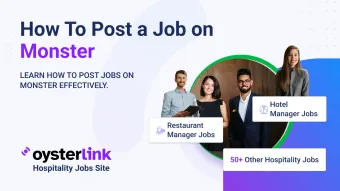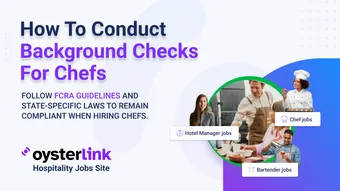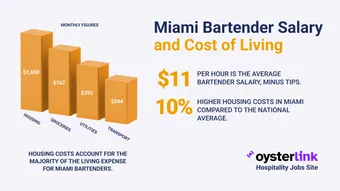How To Write a Restaurant Job Description: Key Findings
- 52% of job seekers say the quality of a job description strongly influences their decision to apply.
- 77% of applicants cite salary as the most important factor when choosing whether to apply for a job.
- Limiting job duties to six items helps prevent clutter and improves readability for candidates.
- Pay transparency can reduce the gender pay gap by up to 30%, promoting equity and attracting more applicants.
While it’s tempting to reuse the same restaurant job description each year to save time, it’s often better to start fresh to ensure it attracts the right candidates. This article will guide you on how to write a restaurant job description that aligns with your business needs.
How to Write a Restaurant Job Description: Key Elements
The essential elements of a job description — tasks, duties, skills, experience, pay, benefits and job title — haven’t lost their importance.
And with 52% of job seekers saying the quality of a job description strongly affects their decision to apply, it’s critical you get each part just right.
Here’s a useful table showcasing what each of these elements should cover.
How To Write a Restaurant Job Description: 8 Key Steps
A clear, well-written restaurant job description attracts better candidates and sets expectations from the start. Here's how to write one that works.
1. Understand the Role and Define the Position Clearly
The first step toward writing an effective restaurant job description is understanding that each restaurant role is unique.
For example, Restaurant Servers are often confused with Waiters.
However, these roles have distinct scopes of responsibilities, with a Server being more focused on engaging with customers, while a Waiter prioritizes taking and delivering orders.
When you compare our Restaurant Server job description to our Waiter job description, you’ll notice that the job description for Servers emphasizes creating a unique dining experience for guests, focusing on a more hands-on approach to customer engagement.
In contrast, our job description for Waiters highlights the essential duties of the role, outlining tasks such as setting and clearing tables.
Clearly defining the position prevents job seekers from applying to your ad and later withdrawing due to a mismatch in expectations.
2. Be Clear and Concise
Avoid using jargon in your job description, as it can be a turn-off for younger job seekers, who make up a significant portion of your target audience.
As a Hiring Manager, you may be familiar with industry-specific terms and use them often in conversations.
However, it’s important to recognize that some of these terms might not be widely understood especially by those just starting their careers in hospitality.
3. Highlight Key Responsibilities and Skills
It’s easy to get carried away listing as many duties and skills as possible for a role. While you may want to be transparent by outlining all potential tasks and required skills, this approach can overwhelm candidates.
Focus instead on highlighting the core responsibilities and essential skills to help job seekers present themselves effectively in their applications.
For example, in our Porter job description, only the main duties are listed. It’s limited to six items, which is an ideal number.
The qualifications are also straightforward, making it clear what’s required for the role without it looking cluttered.
When outlining role responsibilities, it's also beneficial to:
- Prioritize Tasks: List duties in order of importance to provide clarity on primary responsibilities.
- Specify Performance Standards: Define expectations, such as "Ensure customer orders are taken promptly and accurately to maintain a high level of customer satisfaction."
- Highlight Collaborative Efforts: Emphasize teamwork by stating, "Collaborate with kitchen staff to ensure timely and accurate order delivery."
Utilizing Job Description Templates
Leveraging job description templates can streamline the hiring process and ensure consistency across roles.
Resources like the National Restaurant Association provide comprehensive templates for various positions, from servers to kitchen staff.
These templates offer a solid foundation, which can be customized to reflect your restaurant's unique requirements and culture.
By starting with a well-structured template, you can efficiently create clear and appealing job descriptions that attract qualified candidates.
4. Be Specific About the Daily Tasks
In connection to listing only the core responsibilities, you also need to be specific about them.
Let’s say you’re hiring for a Cook position.
When deciding what information should be included in a job description for a Cook, focus on detailing exactly what the role involves to give candidates a clear understanding of the job’s expectations.
Below we’ve illustrated the difference between a specific and vague list of daily tasks for a Cook:
5. Include Required Experience and Qualifications
Similar to keeping your list of duties and responsibilities concise, it’s important not to overwhelm applicants with a long list of required experience and qualifications, especially for an entry-level role.
Only include essential qualifications to minimize the risk of discouraging potentially qualified candidates who might feel inadequate if too many skills are listed.
This is an important step when learning how to write your own job description,
In addition, make sure your job description has a good balance of soft and hard skills to attract well-rounded candidates.
In our Bartender job description, the experience and skills section highlights not only knowledge of cocktail recipes but also important attributes such as communication skills, time management and flexibility.
6. Describe the Work Environment and Conditions
Describing the work environment includes physical, social and psychological factors.
- Physical factors refer to the restaurant’s layout and noise levels.
- Social factors include behaviors that promote a positive work atmosphere and prevent toxicity.
- Psychological factors are things that impact employees' self-esteem, such as recognition programs and growth opportunities.
In contrast, work conditions focus on shift schedules and physical demands.
The work environment can be mentioned in the job overview section.
For example, if you’re hiring a Busser, you might describe the setting as a “busy rooftop restaurant.”
Meanwhile, work conditions can be listed under skills and qualifications. Examples include:
- Ability to stand for eight hours
- Can lift up to 20 pounds
- Available to work on weekends
- Comfortable working at great heights
Being clear about these details saves time and effort as it helps filter out candidates who may be uncomfortable with the job’s requirements, such as those afraid of heights or those who prefer a laid-back, weekday-only position.
7. Be Transparent About Pay and Benefits
Transparency about pay and benefits offers several advantages.
First, it helps reduce the gender pay gap by 30%. This is especially beneficial for women, as it empowers them to request equal salaries when they have comparable skills and experience to their counterparts.

Second, being upfront about salary shows that your organization values honesty and fairness.
Finally, it encourages more job seekers to apply to your job postings. In a case study done in NYC by a job search platform, 77% of job applicants said that salary is the most important factor when deciding whether to apply for a job.
If your salary offering isn’t competitive, you can still attract talent by providing benefits with monetary value, such as health insurance, commuter benefits and 401(k) matching.
In the U.S., several states have enacted salary transparency laws, including California, Colorado and New York. Even if your state doesn’t have these requirements, taking the initiative to share your salary ranges can give you a competitive edge.
8. Close With a Call to Action
Ending your restaurant job description with a strong call to action (CTA) encourages job seekers to apply.
A CTA prompts candidates to take action after reading your job description.
Some commonly used CTAs in job postings include:
- Apply now!
- Join our team by attaching your resume at [link]
- Think you’re a good fit? Send us an email.
These CTAs are short, clear and inviting, making it easy for candidates to understand the next steps. Remember to have a link or a button to the next action you want them to take, and not just add CTA text.
Incorporating Core Values into Restaurant Job Descriptions
Integrating your restaurant's core values into job descriptions not only attracts candidates who align with your culture but also sets clear expectations from the outset. Clearly articulating these values helps potential employees understand the principles that guide your establishment.
For instance, if your restaurant prioritizes sustainability, mention your commitment to eco-friendly practices and seek candidates who share this passion. This approach ensures that new hires resonate with your mission, fostering a cohesive and motivated team.
What To Avoid in Restaurant Job Descriptions
Before sharing your draft, take a final look and ask yourself, which of the following should not be included in the job description?
When writing job descriptions, it’s important to steer clear of using discriminatory, gendered and overly technical language.
For example, mentions of personal characteristics such as “young,” “male” and “single” can alienate qualified candidates who don’t fit those specific criteria.
Being too technical hurts your chances of your job description capturing interest. Here’s an example of a Restaurant Manager job overview that uses overly complex language:
Restaurant Manager
Job Overview:
We are looking for a Restaurant Manager with expertise in advanced inventory control systems and data-driven decision-making. The ideal candidate should excel in managing workforce analytics and optimizing service workflows.
You can improve this by using simpler language to make it accessible to a broader pool of job seekers. The example below highlights the same skills and responsibilities needed but in a manner that’s easier to understand.
Restaurant Manager
Job Overview:
We are looking for a Restaurant Manager with experience in managing stock levels and making decisions based on data. The ideal candidate possesses good leadership skills, commitment to improving customer service and the ability to use data to enhance efficiency.
Check for Typos and Optimize it
Typographical errors, spelling mistakes and grammar issues can damage your company’s credibility.
They give the impression that your organization is careless, unprofessional or lacks a proper review process.
To avoid these mistakes, use an online spelling and grammar checker or get a freelancer editor to go over it. Here are some popular free tools.
Another way to enhance your job description is by optimizing it for SEO. Incorporate relevant keywords to boost the visibility of your job ad across social media, search engines and job boards.
How Do You Incorporate Keywords?
You don’t need to be an SEO expert to know which keywords to use. Start by reviewing the job descriptions of your competitors and noting frequently used terms and phrases. Include these keywords in key sections of your job ad. You can also use synonyms to avoid repetition, but make sure the language remains clear and concise.
Below’s a Chef job description with keywords highlighted.
For more keyword-rich job description templates, visit our job descriptions page.
Post Your Restaurant Job Description
It might sound like a good idea to share your job ad across as many job search engines as possible, especially with the variety of job boards available today. However, it’s important to weigh the pros and cons of doing so.
Instead of posting your job description everywhere, consider using OysterLink, a job platform specifically built for restaurant and hospitality professionals. You can create a job post to attract qualified candidates for both front-of-house and back-of-house roles, expediting your hiring process at a very low cost.
How To Write a LinkedIn Restaurant Job Description
The tips in this article align with best practices on how to write a good job description on LinkedIn, but here are additional suggestions specific to the platform.
- Use a familiar job title: Helps candidates easily identify the role
- Be specific about the job role: Improves LinkedIn’s AI matching and candidate recommendations
- Link your company’s LinkedIn page: Allows candidates to learn more about your company’s culture and values
- Include skills and experience requirements both in the job description and in the “add skills” field: Lets candidates quickly assess whether they meet your requirements without reading your entire post.
How To Write a Restaurant Job Description: Final Thoughts
Writing an effective restaurant job description takes more than listing tasks and qualifications. It’s about clearly defining the role, aligning it with your restaurant’s needs, and presenting it in a way that resonates with job seekers.
From highlighting daily responsibilities to being transparent about pay and values, each detail plays a role in attracting qualified candidates and setting them up for success. Investing time in refining your job descriptions today can lead to stronger hires and lower turnover tomorrow.











Loading comments...